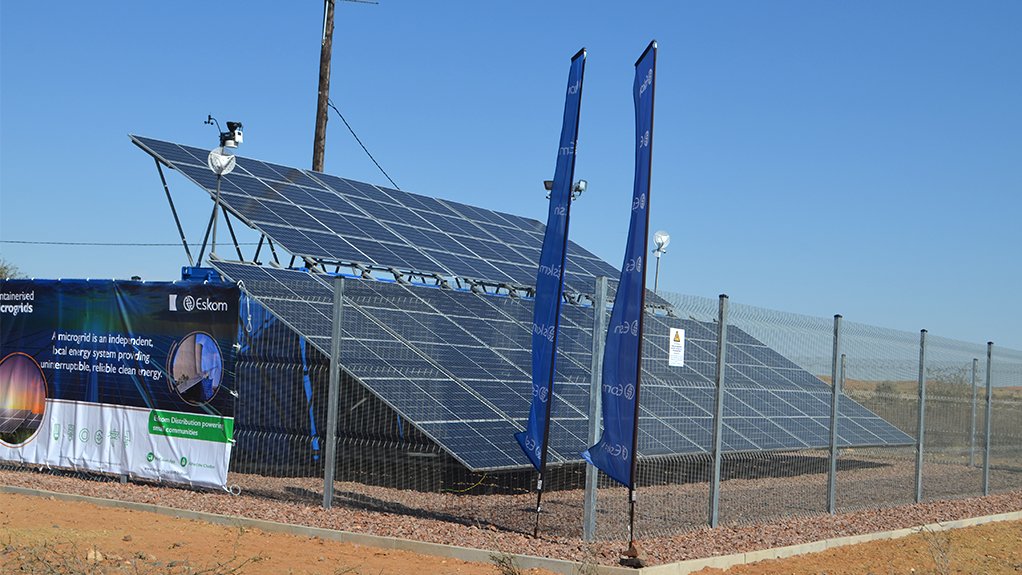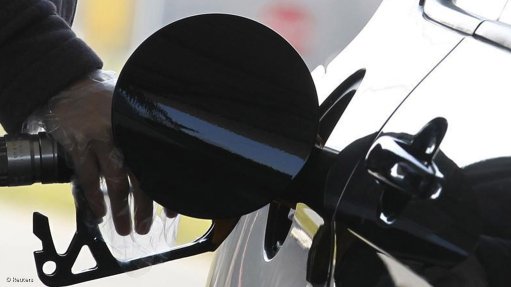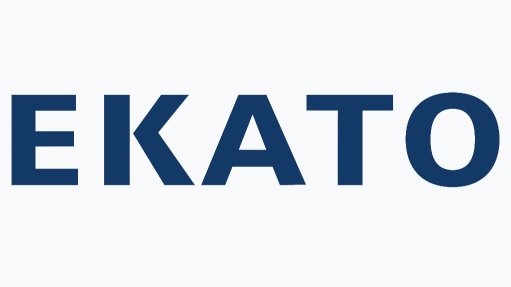Microgrid roll-out gaining traction


SEEING THE LIGHT Eskom has rolled out its third solar microgrid as part of a greater plan to provide universal access to electricity using clean and reliable technologies to remote areas
After the successful commissioning of State-owned power utility Eskom’s third microgrid, at the Swartkop dam, in the Northern Cape, the company aims to launch its next two microgrids at Nomalengena Village, in the Eastern Cape, and Nounieput, also in the Northern Cape, by December 31, 2023.
The microgrids form part of the Department of Mineral Resources and Energy and Eskom’s efforts to achieve universal access to electricity using clean and reliable technologies and entails the dispatching of 100 microgrids across the country by March 2024, depending on suitable sites being identified on time.
Eskom’s media desk tells Engineering News that the locations are selected based on their remoteness and lack of formal infrastructure – such as roads and power lines – in addition to their not being part of any planned power-intensive projects as they are home to very small communities.
“Microgrids are an economical option, as electrifying the remote areas would require long conventional power lines running into hundreds of kilometres, with high costs,” says the media desk.
Additionally, environmental-impact assessments and land acquisition procedures for larger developments could take years to be completed, making microgrids the most viable and the quickest option.
Apart from microgrids being more cost effective, they also contribute to reducing carbon emissions, owing to their incorporating renewable-energy sources.
The microgrids, besides a solar option, can be a combination of micro wind turbines and batteries, as well as hydropower, for areas that have poor solar irradiation, which makes them suitable for powering niche, small and critical loads such as clinics, police stations and telecommunication facilities.
The media desk says that teams are optimising these systems to improve cost and service quality.
The System Explained
The microgrid technology at Swartkop dam will provide electricity for 39 households that did not have access to electricity prior to the implementation of the project.
The electricity networks around the area are constrained and “practically impossible to extend”, hence the area not being connected to the national grid.
The site is powered by two containerised microgrids, each comprising 32 kW or 60 kWh plants that harness solar energy and convert it to a peak of 64 kWh or 120 kWh of electrical energy using photovoltaic panels and power inverters.
The energy from the solar panels is stored in a lithium-ion battery energy storage system totalling 120 kWh of storage. This power output is sufficient for households to use 24/7, owing to the availability of “carefully sized” batteries.
The project also entailed laying the foundations for the microgrid containers, erecting the fencing and gates, as well as installing cameras and lighting to aid surveillance and assist in site monitoring
The media desk adds that Eskom has communication initiatives around the project to foster a sense of belonging and ownership of the microgrids among the communities, which will hopefully encourage them to safeguard the grids and assist in preventing vandalism and theft.
The project also required the supply of conventional electrification infrastructure connected through a metering point, such as aerial bundle conductors, Airdac cables and metering technologies.
The installation of the microgrid follows the successful installations of two pilot microgrid projects at Lynedoch, in the Western Cape, and Ficksburg, in the Free State. The two projects, and Swartkop dam, have demonstrated 100% uptime since commissioning.
“The high solar irradiation in these areas offers an average of 10 h/d of sunlight, which produces sufficient energy for storage in the lithium-ion battery to power the communities.”
Challenging road conditions and the distance covered from the initial point of power to the area being provided were mitigated with little issue and are fairly normal project- related issues to which Eskom is accustomed, concludes the media desk.
Article Enquiry
Email Article
Save Article
Feedback
To advertise email advertising@creamermedia.co.za or click here
Comments
Press Office
Announcements
What's On
Subscribe to improve your user experience...
Option 1 (equivalent of R125 a month):
Receive a weekly copy of Creamer Media's Engineering News & Mining Weekly magazine
(print copy for those in South Africa and e-magazine for those outside of South Africa)
Receive daily email newsletters
Access to full search results
Access archive of magazine back copies
Access to Projects in Progress
Access to ONE Research Report of your choice in PDF format
Option 2 (equivalent of R375 a month):
All benefits from Option 1
PLUS
Access to Creamer Media's Research Channel Africa for ALL Research Reports, in PDF format, on various industrial and mining sectors
including Electricity; Water; Energy Transition; Hydrogen; Roads, Rail and Ports; Coal; Gold; Platinum; Battery Metals; etc.
Already a subscriber?
Forgotten your password?
Receive weekly copy of Creamer Media's Engineering News & Mining Weekly magazine (print copy for those in South Africa and e-magazine for those outside of South Africa)
➕
Recieve daily email newsletters
➕
Access to full search results
➕
Access archive of magazine back copies
➕
Access to Projects in Progress
➕
Access to ONE Research Report of your choice in PDF format
RESEARCH CHANNEL AFRICA
R4500 (equivalent of R375 a month)
SUBSCRIBEAll benefits from Option 1
➕
Access to Creamer Media's Research Channel Africa for ALL Research Reports on various industrial and mining sectors, in PDF format, including on:
Electricity
➕
Water
➕
Energy Transition
➕
Hydrogen
➕
Roads, Rail and Ports
➕
Coal
➕
Gold
➕
Platinum
➕
Battery Metals
➕
etc.
Receive all benefits from Option 1 or Option 2 delivered to numerous people at your company
➕
Multiple User names and Passwords for simultaneous log-ins
➕
Intranet integration access to all in your organisation



















